
November 2022
Issue 59
Who’s Ready to go Ice fishing?
 It’s that time of year. Winter is upon us, and many anglers are swapping out their open-water fishing gear for ice fishing equipment. Are you ready to get out and go ice fishing? Ice fishing is a great way to spend time with friends and family. However, before you head out, be sure to prepare for the elements and make sure the ice is safe enough to walk on.
It’s that time of year. Winter is upon us, and many anglers are swapping out their open-water fishing gear for ice fishing equipment. Are you ready to get out and go ice fishing? Ice fishing is a great way to spend time with friends and family. However, before you head out, be sure to prepare for the elements and make sure the ice is safe enough to walk on.
In this edition of Reel Times, we share some general information on ice fishing, and dive a little deeper into exploring the many ice fishing opportunities in the Matsu Valley. Additionally, if you would like to try ice fishing and don’t have the appropriate fishing equipment, check out the information on our Rod Loaner Program below.
Are you following us on social media? If not, be sure to check us out on Instagram @wefishak. You can also follow us on Facebook at ADF&G - wefishak . Also, visit our YouTube channel for a growing selection of “how-to” videos and much more.
If you have a comment or story ideas for Reel Times, we encourage you to send them our way. You can send comments to ryan.ragan@alaska.gov.
We’ll see you on the water.
Ryan Ragan
Let’s go ice fishing!
 When the weather turns cold, ice fishing is a great way to get out. The gear is simple, the fish are usually hungry, and it’s fun for all skill levels. The best ice fishing is usually right after freeze-up because oxygen levels are still high, and fish are still very active.
When the weather turns cold, ice fishing is a great way to get out. The gear is simple, the fish are usually hungry, and it’s fun for all skill levels. The best ice fishing is usually right after freeze-up because oxygen levels are still high, and fish are still very active.
Where to Go
On ADF&G’s Alaska Lake Database you can zoom in on a map and find out what kind and how many fish were recently stocked in lakes in your area. ADF&G’s hatchery program stocks rainbow trout, Chinook salmon, Arctic grayling, and Arctic char, among other fish.
What to bring
Warm clothes, hand & toe warmers, waterproof boots, hot drinks, and high-energy snacks make a happy day on the ice. A pop-up shelter can help cut the wind. A bucket holds gear and makes a great seat.
Early in the winter, a spud bar can make holes in ice up to 6 inches thick. A hand-cranked or powered auger with sharp blades cuts easily through thicker ice. You’ll need a skimmer or large slotted spoon to remove ice chips from the hole.
How to fish
Any rod & reel will work for ice fishing. Shorter and simpler is preferred. Ice anglers are generally allowed two lines, in which case each line may have just one hook.
Take a look at the sport fishing regulations to see if there are any restrictions on using bait at your fishing destination. Jigging can be done without bait, within about a foot of the lake bottom; the motion and color of the lure attracts fish. When using bait, put a weight on the line about a foot above the hook, and consider using a bobber to keep the hook off the bottom. Some people say small cocktail shrimp works well as bait.
An ADF&G YouTube session on ice fishing basics talks more about ice safety, ice fishing gear, finding productive waters, and fishing regulations.
New to ice fishing? Need gear?
Many Alaska Department of Fish and Game offices have limited basic fishing equipment to loan anglers, free of charge! If you’re still trying to decide if you want to take the leap and buy your own fishing equipment, or have visiting family coming to town, we can help “set the hook” to becoming a lifetime angler by providing short-term loans of our fishing equipment. Depending on the time of year, anglers of any age can borrow spinning rods or ice fishing equipment. For more information, please visit our wefishak rod loaner web page.
Matsu Valley Ice Fishing
By Stephen Dotomain
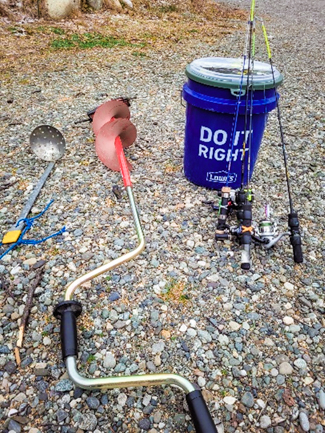 As the summer and fall seasons end and winter takes its hold in the Matsu Valley, many put away the rods and lures and hibernate on fishing. While some do this, there are many that continue to scratch the fishing bug that bites, and do it by grabbing an auger, miniature rods, and an ice scoop. Ice fishing is fun and exciting in the Matsu valley and here are some gear and information on how to get out and be a hardwater fisherman.
As the summer and fall seasons end and winter takes its hold in the Matsu Valley, many put away the rods and lures and hibernate on fishing. While some do this, there are many that continue to scratch the fishing bug that bites, and do it by grabbing an auger, miniature rods, and an ice scoop. Ice fishing is fun and exciting in the Matsu valley and here are some gear and information on how to get out and be a hardwater fisherman.
There are many opportunities in the Matsu Valley for the beginner and advanced angler to pursue fish through the ice, and these include both stocked and wild lakes of this great area of Alaska with a wide range of species and sizes that are available to catch. As with any fishing in Alaska it is best to check your local fishing regulations to stay legal while fishing. There are also many social media outlets that have ice fishing forums that can provide peer to peer knowledge of fishing in the areas you would like to ice fish.
There is no greater way to learn how to ice fish in a new location then to go with someone who is experienced with the area and the gear. There are also some restrictions from area to area for example the Nancy Lake state recreation area and the Susitna Flats State Game Refuge. These areas measure the snow depth and ice, in order, to protect the habitat. Check on these areas prior to accessing. For safety you should familiarize yourself with an ice thickness diagram that shows adequate thickness of ice for various items. Always wear adequate gear to stay safe on the ice.
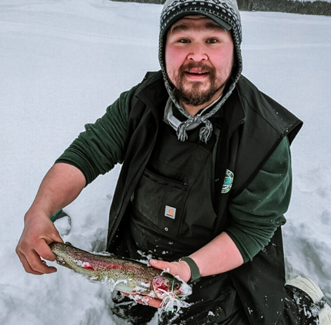 Stocked lakes are a great place for ice fishing, these lakes provide a readily available supply of fish to be caught. There are a few varieties of fish that are stocked including rainbow trout, some landlocked salmon, arctic char, grayling, and now a few lakes have lake trout being stocked. Some of the more popular lakes in the Matsu like Finger Lake in Palmer are also some of the most stocked lakes and provide some of the most fun and easiest to access ice fishing. Many are located right off the road system and have very good public access sites. At most of these lakes bait is allowed, and what I prefer to use for trout is small, cooked cocktail shrimp from the seafood case at the grocery store or cured single eggs. I usually pair the bait up with a nice spoon or jig, but you can also just use a single hook setup with bait too. There are a variety of good baits available at your local sporting goods store like meal worms and jarred baits and if you just ask, they can point you in the right direction. All the information for the stocked lakes can be accessed on the ADF&G website in the Alaska Lake Database. This information tool can be used for the lakes in the area, and some have maps, access points, and if stocked then the number, the date, and size of each species. This is a great start to get informed on the lake you would like to start ice fishing.
Stocked lakes are a great place for ice fishing, these lakes provide a readily available supply of fish to be caught. There are a few varieties of fish that are stocked including rainbow trout, some landlocked salmon, arctic char, grayling, and now a few lakes have lake trout being stocked. Some of the more popular lakes in the Matsu like Finger Lake in Palmer are also some of the most stocked lakes and provide some of the most fun and easiest to access ice fishing. Many are located right off the road system and have very good public access sites. At most of these lakes bait is allowed, and what I prefer to use for trout is small, cooked cocktail shrimp from the seafood case at the grocery store or cured single eggs. I usually pair the bait up with a nice spoon or jig, but you can also just use a single hook setup with bait too. There are a variety of good baits available at your local sporting goods store like meal worms and jarred baits and if you just ask, they can point you in the right direction. All the information for the stocked lakes can be accessed on the ADF&G website in the Alaska Lake Database. This information tool can be used for the lakes in the area, and some have maps, access points, and if stocked then the number, the date, and size of each species. This is a great start to get informed on the lake you would like to start ice fishing.
Wild lakes are often more regulated for a sustained opportunity so that we can enjoy these lakes for the coming future. In addition, wild lakes generally have a wider variety of sizes and species of fish to target. Some have rainbows, grayling, char, and burbot. In addition, some also have whitefish, blackfish, and lake trout. Even further, some wild and stocked lakes have invasive populations of northern pike. Pike are non-native to the Matsu Valley and were illegally introduced into many wild waters and have decreased the native wild fish populations significantly. These fisheries can provide a very fun and dutiful ice fishing experience as there is no limit to the size or numbers you can catch of these invaders. There are differing methods for ice fishing for these toothy invasive species including multiple hooks, spearing, and some lakes you can fish with up to 5 lines for pike through the ice, so check the fishing regulations prior to fishing for northern pike.
 Selecting ice fishing gear for the beginner can be tedious and tough as there are usually several different brands and several different sizes of fishing rods and reel setups. A rule I tend to stick to is to try and start off with a medium weight ice fishing rod that isn’t too expensive. Most of these rods even when they are cheaper still will give you an idea of what you want to do in the future. Selecting a medium weight rod is great for most species in the valley as far as rainbows, and stockers are concerned. Next is an auger, this can be a powered auger that takes gas or batteries, or it can be as simple as a manual screw auger. Manual augers are usually moderately priced and more economical for the beginner. The manual augers are most effective during the earlier season starting from about mid to late December to about mid-February in the valley. During this time the ice is fairly thick (about 12-24 inches) but not so thick that you would need an extender or another partner to help drill holes. A scoop is necessary to clear your ice fishing hole of ice chips that your auger creates. If you do not have a scoop, it can be difficult to send your lure through the hole as chunks of ice create a pillow.
Selecting ice fishing gear for the beginner can be tedious and tough as there are usually several different brands and several different sizes of fishing rods and reel setups. A rule I tend to stick to is to try and start off with a medium weight ice fishing rod that isn’t too expensive. Most of these rods even when they are cheaper still will give you an idea of what you want to do in the future. Selecting a medium weight rod is great for most species in the valley as far as rainbows, and stockers are concerned. Next is an auger, this can be a powered auger that takes gas or batteries, or it can be as simple as a manual screw auger. Manual augers are usually moderately priced and more economical for the beginner. The manual augers are most effective during the earlier season starting from about mid to late December to about mid-February in the valley. During this time the ice is fairly thick (about 12-24 inches) but not so thick that you would need an extender or another partner to help drill holes. A scoop is necessary to clear your ice fishing hole of ice chips that your auger creates. If you do not have a scoop, it can be difficult to send your lure through the hole as chunks of ice create a pillow.
There are many different sizes and lengths of ice scoops but just make sure the scoop isn’t too big for the size of holes your auger makes. As for lures or bait, there are so many different sizes and types of lures, but the most versatile ones are jigs and spoons. These basic heavy bodied lures are effective for most of the species in the valley. I personally like a Swedish pimple or a tube jig. All these items can be purchased at local fishing and outdoor shops, and these shops have very knowledgeable staffs to guide you to success.
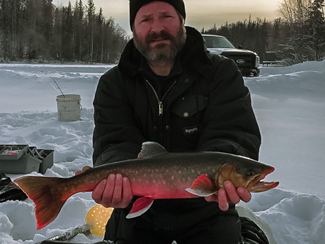 A backpack or a sled is also an option for the beginner. I also prefer to take a bucket to store my fish, lures, and to sit on while jigging. The farther you venture away from the road system the more complex the gear becomes, as there is different gear for different species. One of those species are Northern Pike. One of the best ways to fish for northern pike is with tip-ups and bait. A tip-up is set line with an automatic strike indicator that is basically a flag. Just make sure you have a tip-up that is larger than your auger hole and you have checked the regs for your lake as many lakes have different requirements for fishing for Pike. With tip ups I like to have a variety of bait rigs from small to large as there can be a huge size differential from lake to lake, so I like to use several different setups to figure out what works best in a particular lake. Ice fishing is a subject I could go on and on about, but as I said before, there is no greater way to learn to ice fish then fishing with someone who has done it before, so get out there and fish, I just might see you out there.
A backpack or a sled is also an option for the beginner. I also prefer to take a bucket to store my fish, lures, and to sit on while jigging. The farther you venture away from the road system the more complex the gear becomes, as there is different gear for different species. One of those species are Northern Pike. One of the best ways to fish for northern pike is with tip-ups and bait. A tip-up is set line with an automatic strike indicator that is basically a flag. Just make sure you have a tip-up that is larger than your auger hole and you have checked the regs for your lake as many lakes have different requirements for fishing for Pike. With tip ups I like to have a variety of bait rigs from small to large as there can be a huge size differential from lake to lake, so I like to use several different setups to figure out what works best in a particular lake. Ice fishing is a subject I could go on and on about, but as I said before, there is no greater way to learn to ice fish then fishing with someone who has done it before, so get out there and fish, I just might see you out there.
Purchase your 2023 Sport Fishing License
If you want to get ahead in the final few months of 2022, purchase your 2023 Sport Fishing license!
You can purchase your 2023 Sport Fishing license through our online store, or you can purchase your license through the new ADF&G mobile app.
As we approach the holiday season, a Sport Fishing license makes a great gift for someone. You can purchase a license for someone else in our online store.
Group of friends find adventure and fish on the Wulik River
By Tim Mowry
Tony Garvey, Vance Johnson and Vic Sanchez had been talking about fishing the Wulik River in northwest Alaska for 20-plus years.
All three men grew up together in the Anchorage/Eagle River area in the late 1990s and early 2000s. They all loved fishing and embarked on all sorts of angling adventures in the Mat-Su Valley and on the Kenai Peninsula.
Garvey, who grew up in Wisconsin, moved back to his home state several years ago but he still keeps in touch with Johnson and Sanchez. They try to get together every few years for some kind of fishing adventure. Their last outing was chasing steelhead on the Situk River in Southeast Alaska.
This time, they had their eyes set on the Wulik River, which originates in the De Long Mountains on the North Slope and flows for 80 miles before terminating in the Kivalina Lagoon in the Chukchi Sea east of the village of Kivalina.
“We’re all avid trout and salmon fishermen,” Garvey wrote in an email. “Personally, I’ve always been partial to char such as brook trout, Arctic char and Dolly Varden. There’s something about these fish; when they’re in their fall costume they’re stunningly beautiful.
“We had been talking about this particular trip for 20+ years,” he wrote. “I recall reading about a state-record fish caught there in 2001. I researched travel and cost; at that time, it was unrealistic. I wasn’t sure we’d ever do it.”
In early September, the three childhood friends finally turned their fantasy fishing trip into a reality.
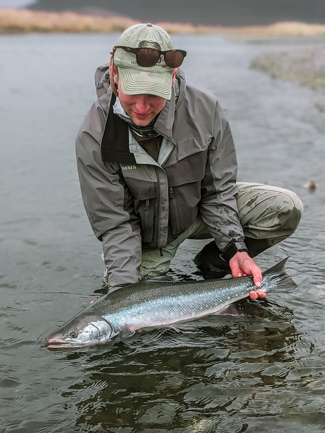 Given the remote location of the Wulik River, the trip posed significant logistical challenges, especially given the fact it was a self-guided trip that included six people.
Given the remote location of the Wulik River, the trip posed significant logistical challenges, especially given the fact it was a self-guided trip that included six people.
“Our party included Vance’s family of two adults and two children, plus Vic and myself,” Garvey wrote. “Vance flew us via his personal aircraft. We utilized a pack raft some. We camped and fished on the banks of the Wulik River for four days.”
Needless to say, the fishing didn’t disappoint.
“Over the course of four days we caught and released a lot of Dolly Varden, chum salmon and grayling,” Garvey reported. “All provided a great deal of fun on the fly rod. Most of the Dollies were between 23-25 inches, with many 27 inchers and a few over 30 inches.
“It was the trip of a lifetime,” he said.
Garvey, Johnson and Sanchez all caught Dolly Varden over 30 inches, which they submitted to ADF&G’s Trophy Fish Program for catch-and-release trophy certificates. Garvey and Johnson each caught 31-inch Dollies while Sanchez netted a 30-incher. The minimum length for a Dolly Varden catch-and-release trophy certificate is 30 inches.
 Fishing for other species in the Wulik was outstanding, as well.
Fishing for other species in the Wulik was outstanding, as well.
“I caught and released several dozen fish each day’” said Garvey, who split his time between fly fishing and spin fishing. “The chum salmon and grayling were an aggressive and exciting bycatch. Most grayling ran 16-18” and were caught on surprisingly big flies and lures at times they weren’t being targeted. The chums never get the respect they deserve; they hammer a fly stripped or swung.
“Most flies and lures were productive to some degree,” Garvey reported. “Mepps Flying Cs were my best lure. Beads worked well and had the added bonus of doing minimal harm to the fish. Dollies had a tendency to ’death roll’ in the net and thrash quite a bit making safe handling and release difficult at times. It's for this reason we came to prefer fishing with barbs smashed down.
“I tried a Moorish mouse for a short while and had some topwater Dolly action,” he said. “In Wisconsin, it’s nearly impossible to get a trout to take down a mouse in daylight but in Arctic fantasyland it appears everything catches fish.”
Invasive European green crabs: A new marine invasive species to Alaska
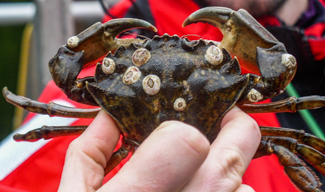
European green crab with barnacles collected from British Columbia. Photo credit ADF&G.
In an article for Alaska Fish and Wildlife News, I suggested that European green crabs might be the next aquatic invasive species Alaska would have to grapple with. I noted the damage they pose to the habitats where Dungeness crabs, salmonids, and other native marine species find food and shelter. You might have seen the map showing where invasive European green crabs have colonized areas of British Columbia, not far from the imaginary line that designates where Canadian waters end, and Alaska waters begin. I described how warming ocean temperatures could facilitate survival of the tiny invasive crab larvae which would be drifting northward among Dungeness crabs disguised in their early life stages, and other plankton riding the Alaska Current up the coast from British Columbia and possibly as far away Washington state during the winter months. While thinking about and writing that article, it is likely that European green crabs had already found a suitable spot to settle and reproduce in a lovely eelgrass meadow in the waters of southern Southeast Alaska because their presence has been confirmed. Clearly, invasive green crabs are not bound by international boundaries.
In July 2022, NOAA Fisheries-Alaska Region staff and their Sealaska Heritage student intern were touring monitoring sites on Annette Island Reserve with Metlakatla Indian Community’s marine invasive species early detection monitor. They stopped at Tamgas Bay to see the recently posted sign that alerts members of the community to look out for invasive European green crabs. During the stop, the team decided to survey the area for molted carapaces of the invasive crab. In fact, molt surveys along beaches are an easy and effective way anyone visiting the Alaska coast, particularly estuarine habitats, can search for signs of invasive green crab. The team searched the beach and upland areas for crab shells. While exploring above the beach zone, the intern’s keen eyes homed in on a smallish carapace. Much to everyone’s surprise and dismay, she had found the first evidence that European green crabs had made it to Alaska, a molted carapace. As the day progressed, two more shells were found. These discoveries sparked the survey team and partner entities in Alaska to focus their efforts on responding to this new invader to Alaska.
Metlakatla Indian Community Department of Fish and Wildlife began intensive trapping immediately to reduce the population. They have deployed traps in Tamgas Harbor, let them soak for 24 hours, and then retrieve them the next day. Not long after European green crab carapaces were found, live invasive crabs were confirmed to be present. Metlakatla’s Department of Fish and Wildlife personnel have been soaking pots daily since July. As of mid-October, they had trapped more than 550 live European green crabs.
Invasive European green crabs: A new marine invasive species to Alaska
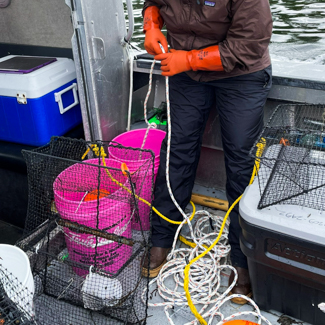
ADF&G preparing to set Fukui traps during European green crab surveys at Foggy Bay, Alaska. ADF&G photo.
While live European green crabs were getting trapped from Annette Island Reserve, the Alaska Department of Fish and Game (ADF&G) began surveys nearby. ADF&G biologists from Commercial Fisheries and Sport Fish divisions, along with myself, the Invasive Species Program coordinator, completed surveys in areas deemed to have suitable habitat. We walked beaches along the road system in Ketchikan and several remote locations in search of molts. Scurrying beneath the rocks along the shoreline, we found species of native crabs in abundance. This included two species of crabs that are smaller than a postage stamp when fully grown. There were purple shore crab (Hemigrapsus nudus), that pinched fingers when they were picked up, and tiny green shore crab (Hemigrapsus oregonensis), sometimes called hairy shore crab. These native crab share the same desired habitat, but are smaller than the invasive European green crab and lack the distinguishing characteristics of five-spines along both sides of the carapace. European green crabs are a type of shore crab that are native to coastal areas of western Europe and northern Africa. We also found plenty of molted shells of Dungeness crab (Metacarcinus magister) and red rock crab (Cancer productus) in a variety of sizes. Only a few graceful decorator crab (Oregonia gracilis) carapaces were found while meandering along the beaches of southern Southeast. Luckily, not one invasive green crab shell was found.
When the weather conditions were suitable, we set traps amongst the eelgrass. European green crabs prefer eelgrass habitat because of the available invertebrates which they devour. Their grazing behavior destroys the vital seagrass where salmon and nearshore invertebrates mingle. Our first stop was Bostwick Inlet on the east side of Gravina Island. A week later we visited Foggy Bay, near the Canadian border, to set traps in the bay and in Very Inlet. Traps were set in the intertidal. We chose protected estuaries, bays with freshwater; areas known to have healthy stocks of Dungeness crabs to protect. Our baited traps were effective at trapping native fish (sculpin, Pacific cod, and even a few perch) and almost 500 vibrant red rock crabs and immature Dungeness crabs. Yet, we didn’t catch one European green crab. As much as it has been a relief to not find a single invasive green crab in our survey areas, I am also motivated to figure out how to improve our chances of finding these crabs. As recent additions to the Southeast Alaska coastal ecosystem the European green crab is expected to be harmful to the habitats and marine resource we rely on for food, employment, and enjoyment. If European green crabs were able to make it to Tamgas Bay, I believe they have settled elsewhere too.
As fall storms surge through the Alexander Archipelago and snow is visible on the mountains, the ADF&G field season wraps up and my attention turns to planning for next year. My focus is now on raising awareness about European green crabs; letting people know how they are threat to our coastal way of life, and the importance of reporting observations of suspect crabs to ADF&G. Long-established partnerships are called upon to help recruit volunteers to engage in actively monitoring for invasive green crabs. As with any evolving program, new relationships will also need to be established to ensure the net of inclusion is cast as wide as possible to tackle this invasive species on multiple fronts. I’m consulting European green crab managers and researchers in British Columbia and Washington state, searching out scientist who understand ocean circulation in nearshore waters. I’m studying papers on movement of invertebrate larvae within the Alaska Current. I look to ADF&G’s biometricians to help improve our survey methods. I believe European green crabs are here, and I want to find them.
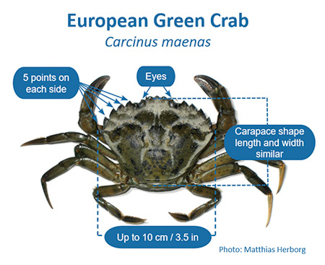
European green crab key characteristics to assist with identification: Five spines or points on either side of the carapace (or shell), three bumps between the eyes, no bigger than a post-it note when full grown. Their color varies from green to brown to yellowish, orangish and red. Unlike Dungeness crabs, they tend not to be purple. Photo credit: Matthias Herborg
You can join our search. Alaskans from Ketchikan to Izembek National Refuge engage in community-based early detection monitoring for European green crabs as citizen scientists. If you have an interest in the coastal community where you live, you can help! Monitoring for European green crab is relatively easy. With gear provided by ADF&G, Alaskans with access to shoreline habitat suitable for green crab can join the marine invasive species citizen monitoring network. Contact ADF&G Invasive Species Program coordinator by calling the Invasive Species Hotline: 1-877-INVASIV or email me.
It's also easy to report observations of suspect crabs. We have great information about European green crabs on invasive species pages of the ADF&G website, including the way they threaten native species and habitats; how to identify these invasive crabs and a guide to help you learn the difference between native and invasive crabs. If you find a crab or crab shell you suspect to be a European green crab, rather than collecting it, take many photos of the crab next to a key, coin or credit card for scale. European green crabs are considered banned invasive species by regulation and may not be collected, possessed or transported without a valid permit. To report your observations, visit our page or call the Invasive Species Hotline: 1-877-INVASIV. To submit photos and for more information about invasive species contact: Tammy Davis, ADF&G Invasive Species Program coordinator: Email or (907) 465-6183
Field to Plate - Recipe of the Month
Recipe of the Month – Sheet-Pan Breaded Alaska Cod with Sweet Potato Wedges.
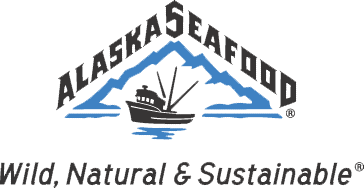 Here’s a delicious recipe for Sheet-Pan Breaded Alaska Cod with Sweet Potato Wedges from the Alaska Seafood Marketing Institute.
Here’s a delicious recipe for Sheet-Pan Breaded Alaska Cod with Sweet Potato Wedges from the Alaska Seafood Marketing Institute.
Enjoy!
If you have any questions about the Reel Times newsletter, please contact Ryan Ragan at ryan.ragan@alaska.gov

